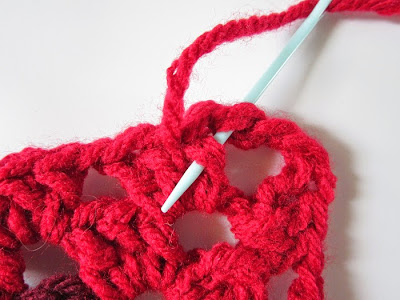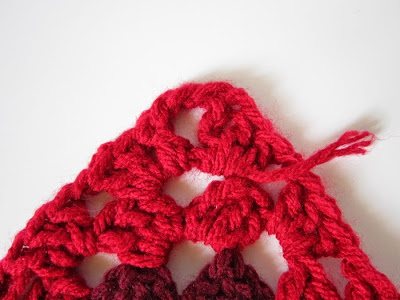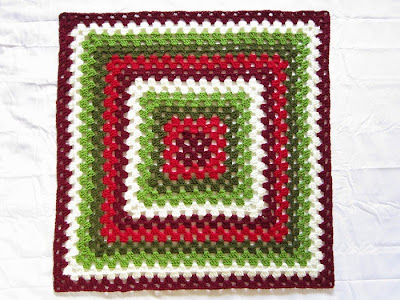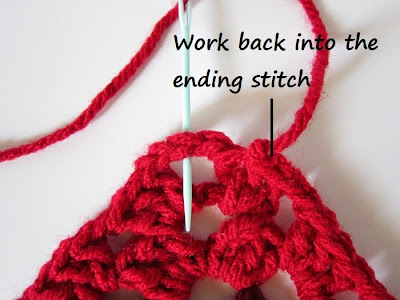Blanket One: The End of a Cursed Project
When I started my work on the Big Granny Square Blanket, I said it was easy. Simple. No problem, it's just a granny square! Ha, ha - Life had different plans for this one. From tangled skeins and evil trolls to dead batteries and the loss of my internet service, it seems like some unseen force has fought the process of creating and sharing both of these blankets. But I have fought it back.
Dispite my troubles, this is an easy project for experienced crocheters. An "evil troll" hasn't been the real problem; it's more like forces of nature and lack of sleep. With the time spent pulling out stitches, I could have taken a nap. But since I can't sleep, I crochet. Through thunderstorms and a perpetual state of exhaustion fueled by coffee and heavy metal, I have stitched, and stitched, and stitched. And ripped, and ripped, and ripped, too... Finally, I've made it right, and both blankets are ready for the World's Biggest Stocking. After the stormy weather knocked out my internet for a few days, I was put behind again. So, sorry for the delay! Better late than never, right?
Get ready for a Grande Finale of posts in honor of the end of the project! First, we'll work through a few more colors. Then, look for another tutorial for beginners - How to weave in your ends. Along with the rest of the rounds, I've thrown in a little "tip", too. I wouldn't call it a tutorial, really, but look for the link to the full tutorial if you need it! In this post, we'll begin with Aran, then work through the rest of the rounds to complete the project. If you missed the post ending with Fresh Green, click here to get caught up.
Please remember, this pattern is not mine - Download all of the patterns for the World's Biggest Stocking blankets here if you need them. And if you're new to the project, click here to start from the beginning. Remember that you don't have to use Caron United, as long as the finished blanket measures 36" (91.5 cm), and keep the colors bright and cheery! Also remember that there's a chance to win $5,000 if you get your blankets in by June 22, 2015! Is that enough remembering now? Let's get started!
-P.S. Although you can make a blanket with any yarn you may have, use Caron United if you can (but beware of trolls). Fifteen cents goes to the Children of Fallen Patriots Foundation for each skein you buy. That's extra-cool.
Okay, beginners - Here's that tutorial for you: How to weave in your ends! (This is my way. I've seen many ways. I like this one. But I still hate weaving in ends.) You may want to read ahead through all of the steps before you begin, to understand the stitch direction and how we will create "fake" stitches.
- - |
| Using this method, we will skip the next stitch, work into the following stitch, and bring it back around, then up - creating a "fake" stitch on top of the real stitch. |
 |
| Insert the needle from back to front in the following stitch. This is going to form the back loop of the fake stitch over the skipped stitch. |
 |
| Here, you can see how you can run the needle right through the center of the skipped stitch and catch the center of the loop underneath at the same time. |
 |
| Once you pull the tail through, you will follow the bottom loop of the stitch up through the center of the skipped stitch. See next step for example. |
 |
| From the bottom, run the needle through the centers of both the skipped stitch and the "fake stitch" that was made over it with the tail. See next step for top view. |
 |
| Looking down at the tops of the stitches, you should see your needle come through the center of both stitches. |
 |
| You will skip the next available stitch. In the next steps, we will make another "fake" stitch over this skipped stitch. |
 |
| Insert the needle from back to front in the following stitch. This is what will create the back loop of the "fake" stitch over the stitch we just skipped. |
 |
| Working into this stitch will create the front loop over the skipped stitch. See the next steps before proceeding for a better example of the loops. |
 |
| The tail is underneath the stitch here because I'm picking up my work. If you make a point to keep the tail above the stitch, it makes it less likely that you will work over it. |
 |
| Make sure you don't work over your tail! From top to bottom, run the needle through the centers of both the skipped stitch and the "fake stitch" created by the tail. |
 |
| Now, we will work out of the corner chain and into the first set of double crochet. Following the bottom loop of the stitch, run the needle through the center of the next stitch from bottom to top. |
 |
| Work through the center of the previous skipped and "fake" stitches. At the same time, follow the bottom loop of the stitch to where it runs through the post (the diagonal loop under the top loop). |
 |
| Turning around, I work in the same method, inserting the needle from the bottom through the tops of the chains, so I know I'm working against the stitches just made. |
 |
| Continue working through the next set of double crochet in the same manner. Work through more stitches if you like, but I trim the end here. There's over six inches (15 cm) of tail woven in there! |
Here's where I have to apologize again: After all those photos for this tutorial, I killed my camera battery. Without thinking, I worked ahead while it charged, and forgot to take a finished photo of the rounds of Cherry. In round Round 23, you will make (3 dc, ch 1) 21 times between each corner; 22 times in round 24. (Remember, that's not counting the corners!) My finished size after these two rounds is about 31" (79 cm).
And now, for your tip! Making two blankets at the same time, I ran out of yarn halfway through the second round of this color, and had to begin a new skein. Weave in more ends? No! Make a Russian Join! Because of my hands, I often have trouble holding a shorter needle, but I can easily hold a longer hook. I decided I'd share my way of getting around this, since I'm sure I'm not alone with this problem. Some yarns are no problem; the needle settles easily between each ply of the yarn, and I can push it through with one finger if I want to. Other yarns, like Caron United, have a springy texture that causes the separate strands to jump off the needle if you move the slightest bit in the wrong direction. You have to hang on to the needle with one hand, and hold tight to the yarn with the other. I often lose my grip, and have to begin again.
For a true step by step tutorial on the Russian Join, you can check out the original here on the blog, complete with horrible background (don't know what I was thinking, there). Or, give my newer Guidecentral guide a try! The pictures in the guide are a little dark, but they're much closer, and at least the background won't burn your eyeballs out.
 |
| Here you can see what it will look like before you pull the tails tight. Kinda messy, right? It's hard to believe this will blend in! |
By the way, if you're asking why you should start a new skein this way, here's my reason: Time spent weaving the tail of a new skein into a project - 10 minutes. Time spent on the Russian Join - 1 minute, 30 seconds. Maybe you're a master end-weaver and it only takes you seconds to get rid of that tail. I think it takes me longer because I'm busy grumbling about how much I hate weaving in ends.
I must admit some disappointment: I really like the contrast of the Aran against the darker colors, and I was kind of hoping to end with that. Plus, it's weird, but I swear the skeins of Aran are softer than the other colors. Is that possible, or is it my imagination? Hmm... Can some yarn guru tell me if the dyeing process can change the texture of the yarn, depending on color?
As for wanting to end with Aran - Oh, well. Lighter colors don't always make for the best borders when you have kids or pets; believe me, I know. That's called "life". Kids will inevitably wipe dirty hands/snot/who-knows-what on the edges of anything! And as much as I love my dog, I don't love his slobber. If I don't hide my pillows and fold up my throws when not in use, he uses the corners to clean up his face after
The end... Of this one!
Links to posts you may have missed:
Happy Crocheting!





























Comments
Post a Comment
This is not a political website. Any comments with political content will be removed. Y'all need to learn how to act right.